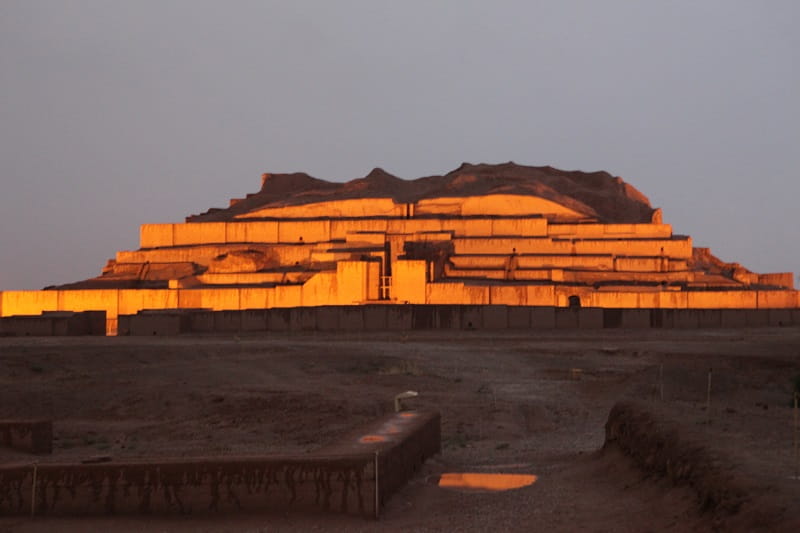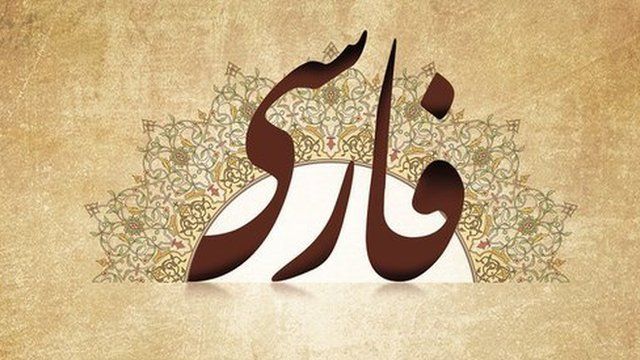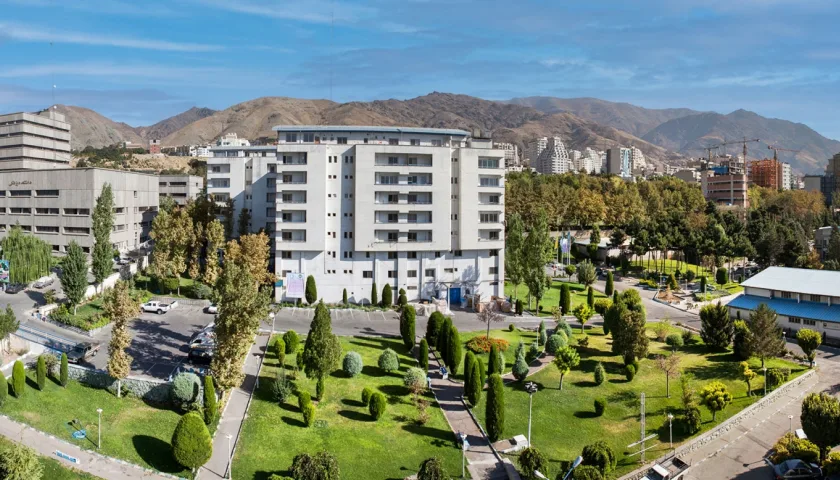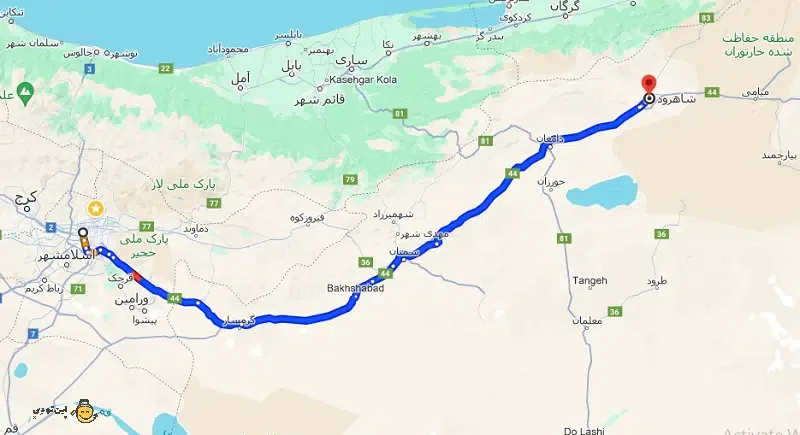13 of Iran’s Most Ancient and Bizarre Historical Cities |The oldest city in iran
Iran, with its thousands of years of recorded history, is home to one of the oldest civilizations in human history. Throughout this long history, hundreds of cities have been built and destroyed in the region.
The land of Iran has hosted ancient civilizations such as Elam and Jiroft, and during the Achaemenid era, it became one of the largest empires in history. According to historical divisions, from the establishment of the Median government to the end of the Sassanian rule, it is known as ancient Iran. Among the governments of that period, the Achaemenids and Sassanians had the longest reigns, ruling alongside Iran for more than 900 years. This era is considered one of the most influential periods in the history of Iran, leaving behind grand ancient buildings and cities.
While there are many ancient cities in Iran, the ones that might come to your mind first are cities like Isfahan and Shiraz. However, the oldest cities in Iran, with traces still remaining, include Shush, Susa, Haft Tappeh, and Pasargadae from the ancient Iranian period. Let’s take a closer look at some of these ancient cities.
1. Shush (Susa):
National Heritage of Iran
Current Location: Khuzestan Province
Age: 6,000 to 9,000 years
Shush, considered by some researchers as the oldest city in the world, still thrives in the heart of Khuzestan. Located 115 kilometers northwest of Ahvaz, Shush has been the center of Elamite rule, the capital of the first civilization in Iran, and the winter capital of the Achaemenids. The Ziggurat of Chogha Zanbil, the Palace of Ardeshir, the Ivan-e Karkheh, the ancient mounds of Shush, the tomb of Prophet Daniel, Haft Tappeh, the tomb of Deybal Khazaii, and the Palace of Apadana Darius are some of the remaining artifacts from its peak and flourishing period. Although the exact founding date of Shush is not clear, historians estimate its antiquity to be between seven to four thousand years before Christ.
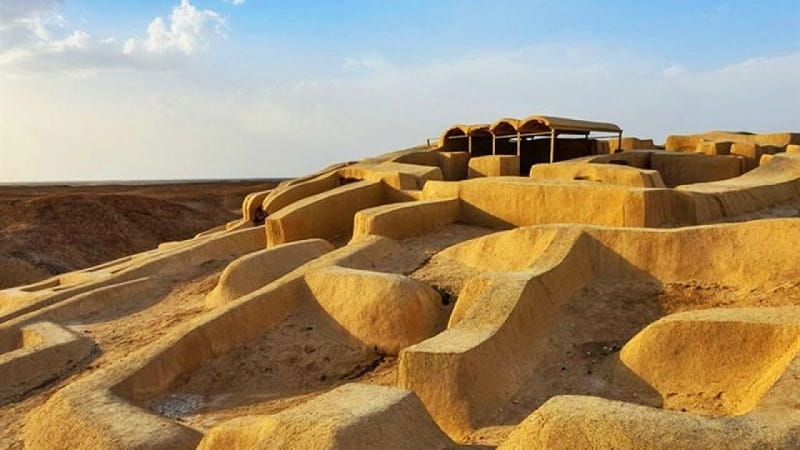
Shush, also known as Shush-e Susa, Sushiana, or Shushan, is one of the most fascinating and historical cities in Iran, and it is said to have been the capital for two thousand years. The city thrived until the Mongol invasions, after which its prominence declined. Shush is recognized as one of the oldest known settlements globally, and archaeological activities continue to unveil its ancient secrets. The historical site of Shush is registered in the National Heritage of Iran, and it gained international recognition in 1394.
Shush covers an area of five square kilometers, situated at an elevation of 78 meters above sea level. The Karun, Dez, and Shavur rivers flow through this city. Its geographical location has led the majority of its inhabitants to choose occupations such as trade, fishing, and agriculture. When visiting Shush, besides exploring its mesmerizing historical attractions, don’t miss the opportunity to buy local handicrafts and souvenirs, including kupo (traditional hat), pottery and wood paintings, and filigree and marquetry.
2.Burnt City:
National Heritage of Iran
UNESCO World Heritage
Current Location: Sistan and Baluchestan Province
Age: Over Five Thousand Years

The Burnt City, located in the Sistan and Baluchestan Province, approximately 120 kilometers south of Zabol, boasts a history of over five thousand years, as evidenced by archaeological findings. Recognized as one of the world’s oldest civilizations, this city is considered a valuable region for archaeologists and history enthusiasts due to its prominent historical features and a vast collection of discovered artifacts. In the past, the Burnt City served as a significant route connecting the Indian subcontinent and Central Asia with the civilizations around the Persian Gulf, encompassing a substantial part of ancient Iranian civilization and the cultural roots of the Eastern Iranian Plateau.
The world’s oldest backgammon board and the oldest artificial eye were discovered in the Burnt City. Additionally, the first brain surgery on record took place in this city.
Built on elevated mounds, ranging from 12 to 18 kilometers in height, and situated on the banks of the Hirmand River, the Burnt City is considered one of the most advanced ancient civilizations. Some historians even compare it to the Bronze Age Jiroft Civilization. The vast area of the Burnt City features numerous historical attractions, although, due to its high historical value, it is relatively less known among Iran’s tourist destinations. The warm and dry climate of Sistan and Baluchestan, along with limited recreational facilities in the region, has contributed to the city’s lesser-known status. In 1393, the Burnt City was inscribed as the seventeenth historical site in Iran on the UNESCO World Heritage list.
Covering an area of approximately 280 hectares, the Burnt City had an advanced water supply and sewage system. It was divided into five main sections, including residential areas in the northeast and east, extensive central regions, an industrial sector in the northwest, and commemorative buildings and a cemetery in the southwest. The industrial sector was located outside the city, at a distance from residential areas.
Various industries, such as marquetry, goldsmithing, straw weaving, weaving, and pottery, thrived in the Burnt City. Artifacts obtained from excavations in this city, including ornamental items, testify to the prevalence of these crafts. It’s noteworthy that the world’s oldest backgammon board and the oldest artificial eye were found here. Additionally, the first recorded brain surgery took place in the Burnt City.
A crucial question for archaeologists investigating the archaeological site of the Burnt City was why the city burned, and whether it truly suffered from a fire. Initial examinations revealed extensive layers of ash in the area and evidence of fire damage to structures, leading researchers to conclude that the city indeed experienced destruction by fire. Some experts believe that the Burnt City was set ablaze twice: once during its growth and flourishing period, and the second time during its demise. It is essential to note that current scholars believe the presence of ash layers in the area, resulting from the industrial activities surrounding the Burnt City in the past, and climatic changes, coupled with the decline in industrial and commercial activities, were among the primary reasons for the city’s decline.
4.Hesar Mound:
National Heritage of Iran
Current Location: Damghan City, Semnan Province
Age: Three to Six Thousand Years
The Hesar Mound is one of the oldest cities in Iran, situated in the northern part of Semnan Province. Located in the village of Heydarabad, three kilometers southeast of Damghan city, the civilization at this mound dates back to the fourth millennium to the first millennium BCE. The inhabitants of Hesar Mound constructed their homes using raw clay, and remnants of these structures can still be seen in the form of ruins. Historical evidence indicates that this city faced a severe invasion, leading to its complete destruction.
In September 1310 Solar Hijri, Hesar Mound was registered in the National Heritage list of Iran, marking it as one of the most valuable prehistoric sites on the Iranian Plateau. Hesar is a low mound, only a few meters high, with some protrusions, covering an area of 300 by 200 meters, though it was more extensive in the past. The name “Hesar Mound” is first mentioned in the travelogue of Schindler, an English officer involved in constructing and laying the telegraph line from Bombay to Europe and London, during the Qajar era and the reign of Naser al-Din Shah.
Research on the archaeological site of Hesar Mound dates back to before the revolution. According to these studies, Hesar Mound has three cultural periods pre-dating recorded history, making it one of the crucial industrial centers on the Iranian Plateau during the third and fourth millennia BCE. Studies indicate that settlement and life at Hesar Mound persisted from 4200 to 1700 BCE, encompassing the Copper and Bronze Ages. The mound was abandoned around 1700 BCE during the second millennium.
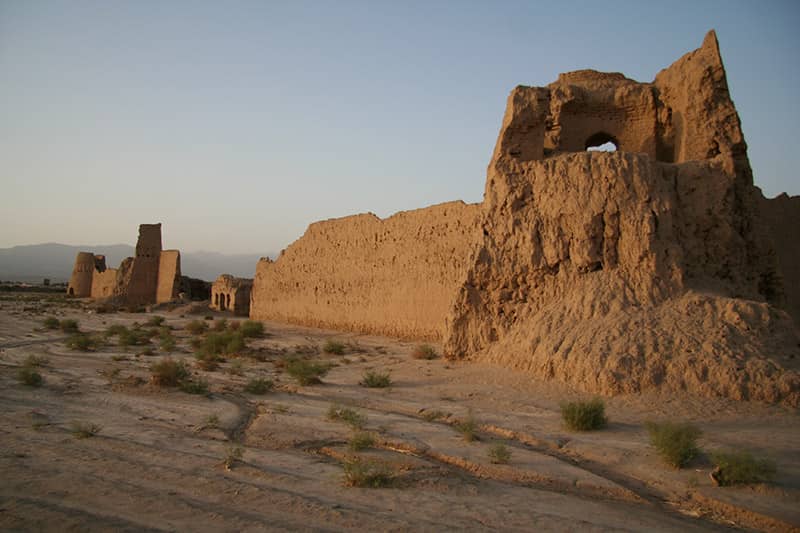
During the historical era and later in the Sasanian period, a palace was built on Hesar Mound. Cultural artifacts from the Islamic era, such as castle-like structures, also suggest the continuity of habitation in this area. Hesar Mound is significant because it provides a glimpse from the Metal and Stone Age of Iran to the Bronze Age.
The archaeological site of Hesar Mound has yielded various objects and artifacts, including pottery from the Copper Age (pottery with lentil-shaped impressions featuring designs such as horned animals and gray ashtray-like pottery with embossed, incised, added, and raised patterns), vessels with button, stem, pipe-shaped jars, bowl-like cups, and utensils, as well as diverse metal objects like bracelets, rings, and pins. Other findings include stone tools such as rectangular stone blades, sharp-pointed stone drills, and engraved clay objects.
For a closer look at the objects and findings from Hesar Mound, visit the Garmabeh Museum in the old bazaar of Semnan city. The museum hosts a permanent exhibition of artifacts obtained from Hesar and other locations in the province. One of the most intriguing findings by archaeologists at Hesar Mound is the skeleton of a mother who died during childbirth.
While Hesar Mound is listed in the National Heritage of Iran, unfortunately, the railway line from Tehran to Mashhad passes through a part of this historical site, hindering its inscription as a UNESCO World Heritage site. Fragments of handmade pottery, valuable for their historical significance, are scattered throughout the mound, exposed to the risk of erosion due to water and wind, as well as temperature fluctuations. Hopefully, a project for their urgent collection and preservation will be initiated to safeguard this ancient artifact further.
5.Dakyanus City:
National Heritage of Iran
Current Location: Jiroft City, Kanar-e Sandal Village, Kerman Province
Age: Five to Seven Thousand Years
The Jiroft Civilization, a five-thousand-year-old enigma, is one of the lesser-known ancient civilizations in Iran. Dakyanus is a part of the Jiroft Civilization, buried in the soil until revealed by a river flood. In 2009, more sections of this city, such as a mosque, pottery kiln, cemetery, bathhouse, and bazaar, were discovered. Research on the ceramics, inscriptions, and stone artifacts indicates the existence of an ancient civilization in this region.
In 1379, inscriptions found in Jiroft revealed that the inhabitants of this city were proficient in writing long before the Sumerians, challenging the historical notion that the Sumerians were the inventors of writing.
What we refer to today as Dakyanus City is situated in the northeast of Jiroft, next to the Halil River, boasting a history of seven thousand years. This dreamlike and advanced land in the ancient world was known as “Art,” a city rich in agricultural lands, mines, and a crossroad for various caravans, making it immensely prosperous. Art was the first city where people initiated the practice of writing.
Interestingly, historical records suggest that the Sumerians were the first to invent writing. However, inscriptions discovered in Jiroft in 2000 B.C. demonstrated that the people of this city were already proficient in writing long before the Sumerians. The abundance of wealth and prosperity in Dakyanus led to numerous attacks from neighboring regions, including the Akkadians.
The Islamic city of Dakyanus, located in the northern part of Jiroft City, dates back to the Seljuk period (900 years ago). It was considered one of the largest Islamic cities in the country, covering an area of 12 kilometers. During the Seljuk rule, it played a pivotal role in trade and attracted many tourists. The name Dakyanus even appears in the travelogue of the renowned Italian explorer Marco Polo as a magnificent city.
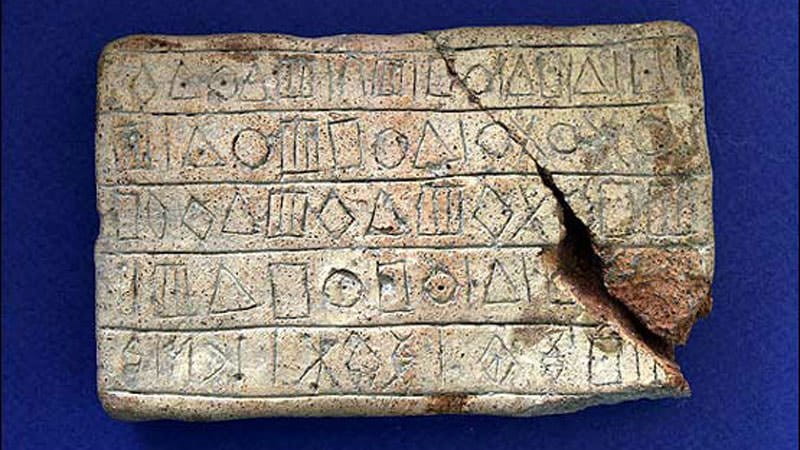
Today, to visit Dakyanus City, one must go to Kanar-e Sandal village, five kilometers west of Amberabad and thirty kilometers south of Jiroft City. Approximately 1300 square meters of Dakyanus City have been unearthed from beneath the ground. It is said that Dakyanus had more than 100 neighborhoods and 100 open spaces, indicating the vastness, population, and economic, political, social, and cultural vitality during the Seljuk period.
Many of the artifacts discovered in Dakyanus have been sold at international auctions over the years, finding their way into museums outside Iran. However, some findings from the Kanar-e Sandal archaeological site are preserved in the Jiroft Archaeological Museum, offering visitors a glimpse into this ancient civilization.
6.Sialk Mound:
National Heritage of Iran
Current Location: Fin, Kashan, Isfahan Province
Age: Over 7500 Years
Sialk Mound, located near Kashan, stands as a testament to the ancient inhabitants of the Iranian plateau who transitioned to settled life in plains due to climatic changes almost 5000 years before Christ. The oldest settlers in the plains were the people of Sialk, whose artifacts have been unearthed through archaeological excavations. Sialk Mound, or the ancient site of Sialk, is an archaeological hill in the Fin region of Kashan, with a history dating back over seven thousand years. Constructed from mudbrick and clay, this mound represents the ziggurats or Iranian temples. The ziggurats were built in a distinctive architectural style resembling a stepped pyramid, similar to those found in major cities between the Tigris and Euphrates (modern-day Iraq) and Iran.
In the past, Sialk was known as the city of Nareen and is now considered one of the oldest cities in Iran. This ancient civilization, dating back thousands of years, was discovered approximately 80 years ago with the onset of flooding in the agricultural lands of Kashan. Unfortunately, much of the treasures of this area were plundered by antiquities dealers and looters. Eventually, Roman Ghirshman, the archaeologist from the Louvre Museum in France, came to Iran with the aim of understanding and preserving the civilization that belonged to all people worldwide.
Ghirshman, along with his archaeological team, conducted three seasons of excavation on both Sialk mounds and two nearby cemeteries in 1933, 1934, and 1937. In 1938 (1317 solar calendar), he published two volumes titled “Sialk Kashan” in French, later translated into Persian by the Cultural Heritage Organization of Iran. Ghirshman estimated the history of this civilization to be around 10,000 years.
Despite Ghirshman’s efforts and the publication of his reports, Sialk did not receive much attention until 1380 (solar calendar). Many areas of this site were converted into agricultural lands over time. Dr. Sadegh Malek Shahmirzadi, a prominent Iranian archaeologist, later visited Sialk to continue excavations. With five seasons of exploration until 1385 (solar calendar), he succeeded in publishing several books about this region.
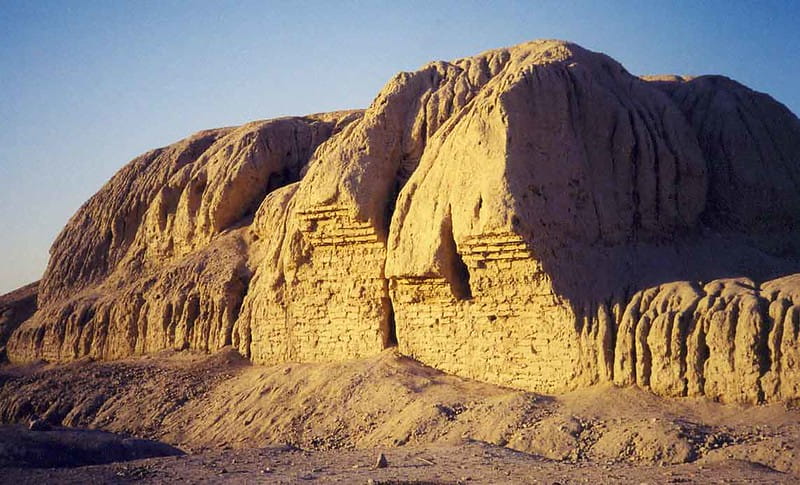
Sialk Kashan is listed in the historical and national heritage of Iran and has been included in the World Heritage temporary list since 1997. The Sialk mounds, located in the southwestern corner of Kashan, on the right side of the Kashan-Fin road on Amir Kabir Street, include two northern and southern mounds or the “A” and “B” cemeteries, spaced 600 meters apart. The remaining artifacts discovered from this mound are stored in a small museum within the Sialk mound site, and it is hoped that authorities will take further measures to protect this historical and archaeological city.
7.Persepolis:
National Heritage of Iran
UNESCO World Heritage Site
Current Location: Marvdasht, Shiraz, Fars Province
Age: Achaemenid Period (2500 Years)
Persepolis, also known as Parsa, is one of the ancient cities of Iran and served as the magnificent capital of the Persian Empire during the Achaemenid era. The city boasts the presence of a palace named Takht-e Jamshid (Throne of Jamshid), which was constructed during the reigns of Darius the Great, his son Xerxes, and Artaxerxes I. This historical city remains one of Iran’s most prominent tourist attractions and a key highlight in Fars Province.
Persepolis and its surrounding structures, including columns, gateways, inscriptions, reliefs, palaces, and gates, are among the most significant historical documents of civilization in the world. Renowned scientists and archaeologists from around the globe have traveled to Iran to witness the grandeur of Persepolis. Situated north of Marvdasht in northern Fars Province, Persepolis dates back to 518 BCE, marking the beginning of construction as the new capital of the Achaemenids. It is believed that the vast complex included 39 residential areas, accommodating around 43,600 residents during the Achaemenid era. Historians contend that Alexander the Great invaded Iran in 330 BCE, set fire to Persepolis, and destroyed a substantial part of the Achaemenid books, culture, and art.
The splendor and beauty of Persepolis’s structures continue to astonish contemporary designers and engineers, to the extent that recreating such a colossal complex with today’s extensive facilities is considered a challenge. Following the conquest of Persia, the Sassanian kings left inscriptions in Persepolis, particularly in the Tachar palace. Even in the Islamic era, this site remained respected. During this time, Persepolis was known as Hazar Sutun or the City of a Thousand Columns, associating it with figures such as the Prophet Solomon and Jamshid.
In 518 BCE, the construction of Persepolis began as the new capital of the Achaemenids. It is believed that the vast complex included 39 residential areas, accommodating around 43,600 residents during the Achaemenid era. Historians contend that Alexander the Great invaded Iran in 330 BCE, set fire to Persepolis, and destroyed a substantial part of the Achaemenid books, culture, and art.

The splendor and beauty of Persepolis’s structures continue to astonish contemporary designers and engineers, to the extent that recreating such a colossal complex with today’s extensive facilities is considered a challenge. Following the conquest of Persia, the Sassanian kings left inscriptions in Persepolis, particularly in the Tachar palace. Even in the Islamic era, this site remained respected. During this time, Persepolis was known as Hazar Sutun or the City of a Thousand Columns, associating it with figures such as the Prophet Solomon and Jamshid.
8.Pasargadae:
National Heritage of Iran
UNESCO World Heritage Site
Current Location: Marvdasht, Shiraz, Fars Province
Age: Achaemenid Period (2500 Years)
Pasargadae, part of the UNESCO World Heritage Site, is a collection of ancient structures dating back to the Achaemenid era, located approximately 130 kilometers north of Shiraz in Fars Province. This complex includes significant structures such as the Tomb of Cyrus, the Pasargadae Royal Garden, the Gatehouse, a bridge, the Audience Palace, the Private Palace, two pavilions, fountains of the Royal Garden, the Tomb of Cambyses, the structures of Dafne Tepe, the Mazar-i-Mofaq archaeological site, and the Balaghi Gorge. Pasargadae is the fifth registered site on the World Heritage list in Iran.
It is highly likely that Cyrus the Great ordered the construction of this magnificent complex. Evidence such as a trilingual inscription (Elamite, Old Persian, and Akkadian) and architecture almost similar to Persepolis strengthens this possibility. According to Herodotus, after numerous conquests in 526 BCE, Cyrus attacked the Saka tribes in Central Asia. Unfortunately, he was killed in a battle against the Massagetae, a semi-nomadic Iranian people in Central Asia, and was buried in Pasargadae. Pasargadae is situated in a valley at an elevation of 1,900 meters above sea level, surrounded by mountains.
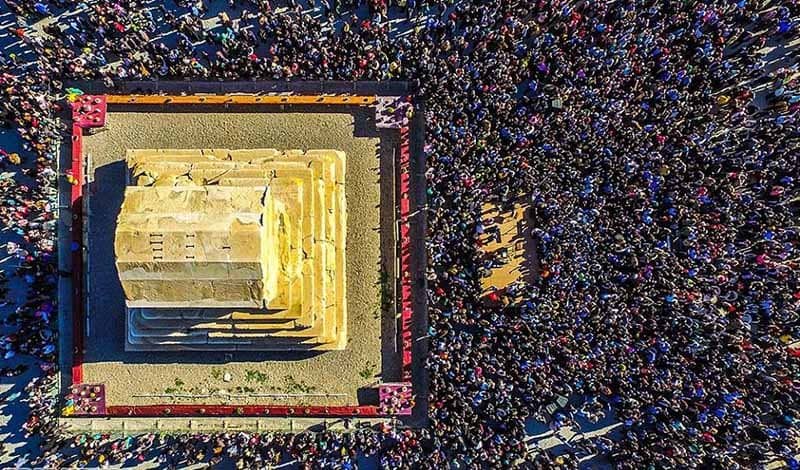
The major structures in Pasargadae are constructed using materials such as stone, bricks, raw clay, and wood. The red bricks used in this complex are 45 cm long, 22 cm wide, and 5.5 cm in diameter. White limestone, hard blue stone, and brittle black marble-like stone are also among the materials used.
9.Hegmataneh (Hamedan):
National Heritage of Iran
Current Location: Hamedan
Age: Approximately Three Thousand Years
Hegmataneh, founded by the Aryan Medes in the 7th century BCE, serves as one of Iran’s valuable and ancient artifacts. With a history of over three thousand years, it is listed in the National Heritage of Iran. According to the remaining artifacts, it seems that Hegmataneh was established by the Aryan Medes in the 7th century BCE and served as the first capital for Iranian emperors and kings. This city also acted as the summer capital for the Achaemenids and Sassanians. The Greeks knew Hegmataneh as Ecbatana.
Hegmataneh is considered one of Iran’s ancient and valuable artifacts, a historical city with a history of over three thousand years, registered in Iran’s National Heritage list. According to some historians, it was the first capital of Iran and, alongside Athens in Greece, Rome in Italy, and Shush in Khuzestan, was one of the few living ancient cities globally. Herodotus, the first Greek-speaking historian, attributes the construction of this city to Deioces (9th century BCE) and mentions that Hegmataneh had seven concentric walls, each painted in the color of one of the planets.
In 550 BCE, Astyages, the Median king, was defeated by Cyrus the Great, leading to the capture of Ecbatana by Cyrus. Noteworthy features of the ancient city of Hegmataneh include its orderly architecture and plan, making it unique among discovered ancient artifacts. Valuable artifacts have been unearthed during excavations in Hegmataneh, some of which are available for public viewing in the Hegmataneh Museum and the National Museum of Iran.
10.Harireh City:
National Heritage of Iran
Current Location: Kish Island, Bandar Lengeh County, Hormozgan Province
Age: Approximately 1000 Years
The relics and ruins of the ancient city of Harireh are situated on Kish Island, alongside the Olympic Sports Complex, nestled within caves and mountains. Harireh was known for its outward-looking nature at a time when cities had defensive walls; this city, however, lacked such fortifications. Flourishing from the 4th to the 10th century AH, Harireh covers an area of 120 hectares. Archaeological excavations have revealed a historical complex consisting of a coastal area, A’yan Mansion, a bathhouse, a historic mosque, glassblowing workshops, and ancient aqueducts.
Merchants from Siraf, in the middle of the 4th century, decided to establish themselves in Kish after the economic decline of the Siraf trading port. Harireh is described as a vibrant, wealthy, beautiful, and lush city. Its name, Harireh, is believed to be derived from its lushness and the tranquility found within.
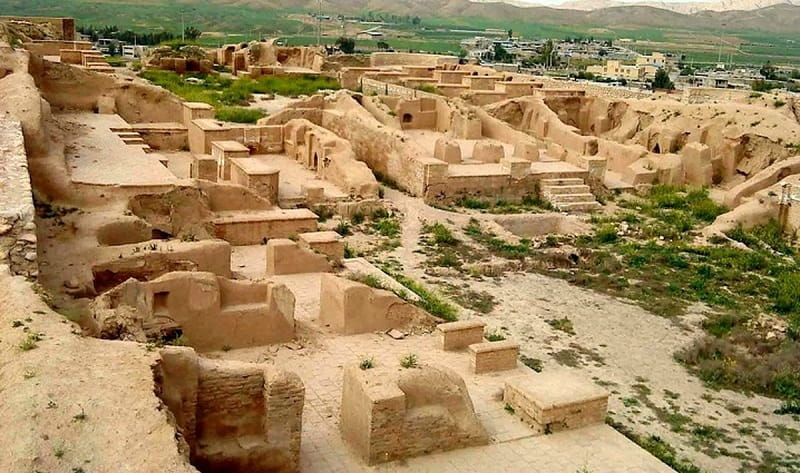
Currently, few structures with intact roofs and coverings remain in Harireh. Nevertheless, upon entering the archaeological site, the remnants of demolished buildings offer a detailed view of a cohesive city with distinctive architecture. Harireh’s ancient city is comprised of robust structures made of limestone and coral stones, while contemporary cities used adobe bricks. During a visit, one can observe sturdy stone walls with plaster coatings, likely constructed to withstand potential attacks.
11.Simorgh City:
National Heritage of Iran
Current Location: Delfan County, Ilam Province
Age: Sasanian Period
Simorgh City, dating back to the Sasanian and early Islamic periods, is located on the eastern outskirts of Delfan County, west of the Sarab River. As the largest historical site in Ilam Province, covering 200 hectares, it is one of the earliest entries in the National Heritage list of Iran. Simorgh City likely served as the center of the Mehragan-Kazak region, acting as its summer capital.
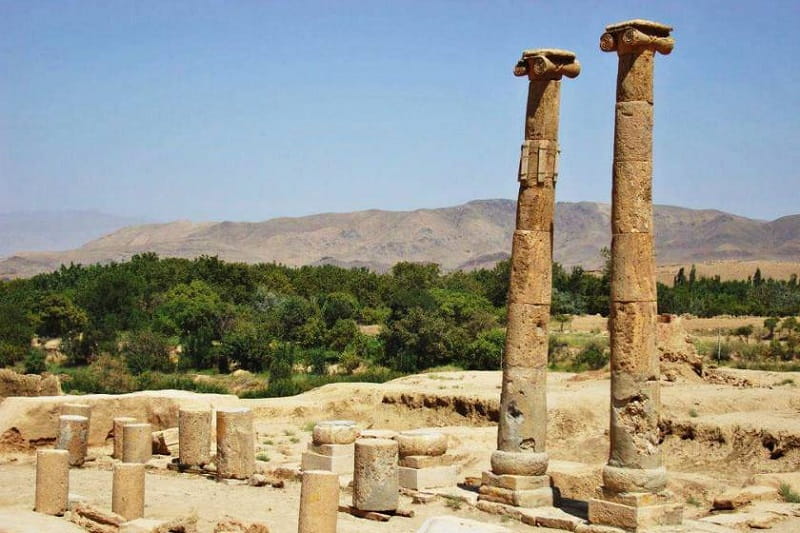
In 334 AH, it is believed that Simorgh City was abandoned due to an earthquake. Over nine seasons of excavation, unique gypsum reliefs, an aristocratic residence, a mosque structure, flood control facilities, and peripheral residential areas have been discovered. Simorgh City is also a candidate for inscription on the UNESCO World Heritage list.
12.Nimvar City:
National Heritage of Iran
Current Location: Mahallat County, Markazi Province
Age: Sasanian Period
Nimvar City, situated 250 kilometers from Tehran on the Mahallat to Delijan route, is part of the historical regions of Iran. Some areas around this city, such as ancient mounds and the One Well Cave in Baqerabad, show evidence of habitation dating back to the third millennium BCE.
Thriving during the Sasanian era, Nimvar is believed to have been named “Avard,” meaning battlefield, during the Ashkanian period. After the wars of the Ashkanians, it became known as “Nim Avard,” eventually evolving into “Nimvar” over time. The term “Var” in Pahlavi signifies a fortress, and the presence of remains from a large fortress surrounding the city supports the hypothesis that Nimvar was a city within a castle.
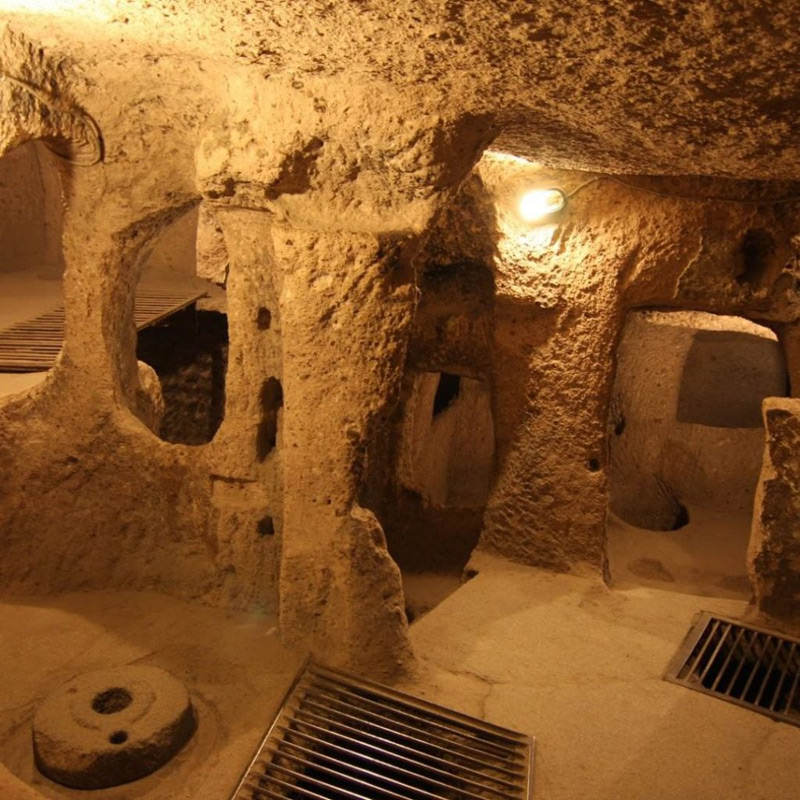
Notable historical attractions in Nimvar include the Milune Temple (the remnants of a vast ancient structure), the Atashkuh Fire Temple (one of the largest fire temples from the Sasanian era), the Nimvar Refrigerator (west of Nimvar City), and the historic Baqerabad Bridge. All these ancient artifacts are registered in the National Heritage list of Iran.
13.Nushabad City:
National Heritage of Iran
Current Location: Aran va Bidgol County, Isfahan Province
Age: Sasanian Period (1500 Years)
Nushabad is located in the central part of Aran va Bidgol County, five kilometers from Kashan, with a history dating back 1500 years to the Sasanian era. It is said to have been one of the capitals during the rule of Anushiravan. The underground city of Ouyi is one of the most important attractions in Nushabad, considered one of the most astonishing subterranean cities globally. Discovered accidentally in 2006 by an individual digging a well at home, it is believed to have served as a refuge for the people during the Mongol invasions. Many details of the city have been lost due to floods and the passage of time, but discovered pottery indicates a history of 1800 years from the Sasanian era. This underground city was used from the Safavid era to the Qajar period.
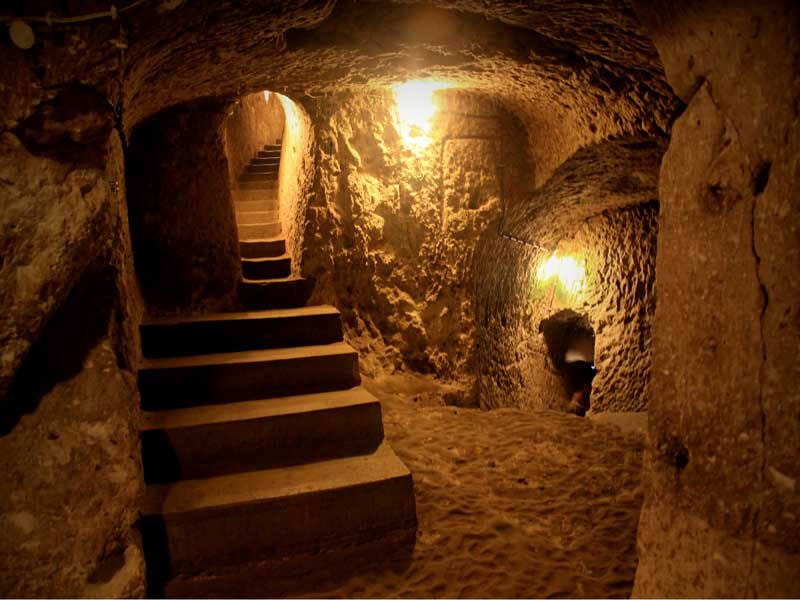
To enter Ouyi City, there is only one entrance. After descending 45 steep steps, you will encounter a dense structure with numerous corridors deep within the earth. This beautiful and unique city was registered as a cultural heritage site in 2006. Unfortunately, many tourists are unaware of its existence – a captivating attraction that will leave you amazed.
Other attractions in Nushabad include the Jame Mosque and Imam Ali Mosque from the Mongol period, the adobe castle of Si Zan, and the historical Isaakabad Bridge from the Seljuk era. Archaeological research indicates that after the migration from the mountains during the Covenant of Hajr, humans settled in the plains. These settlements, such as Kashan (Silk Hill), Qom, Rey, and Damghan, existed. After the destruction of Silk Hill (14 kilometers southwest), in the early first millennium BCE, the victorious invaders chose the current Fin for settlement. Subsequently, small and large habitations like Aran Dasht, Bidgol, Nushabad, Nyaser, and Varzabad emerged.
Frequently Asked Questions:
How old is the city of Deh Qianus in Jiroft?
The city of Deh Qianus dates back to five to seven thousand years ago.
In what year did the construction of Persepolis begin?
The construction of Persepolis, as the new capital of the Achaemenids, began in 518 BCE.
Why did the city of Soghdha disappear?
Climate changes and the decline of industry and trade are among the main reasons for the decline of the city of Soghdha.
What is the most important attraction of the ancient city of Nushabad?
The underground city of Ouyi is one of the most important attractions in this city and one of the most astonishing underground cities globally.

